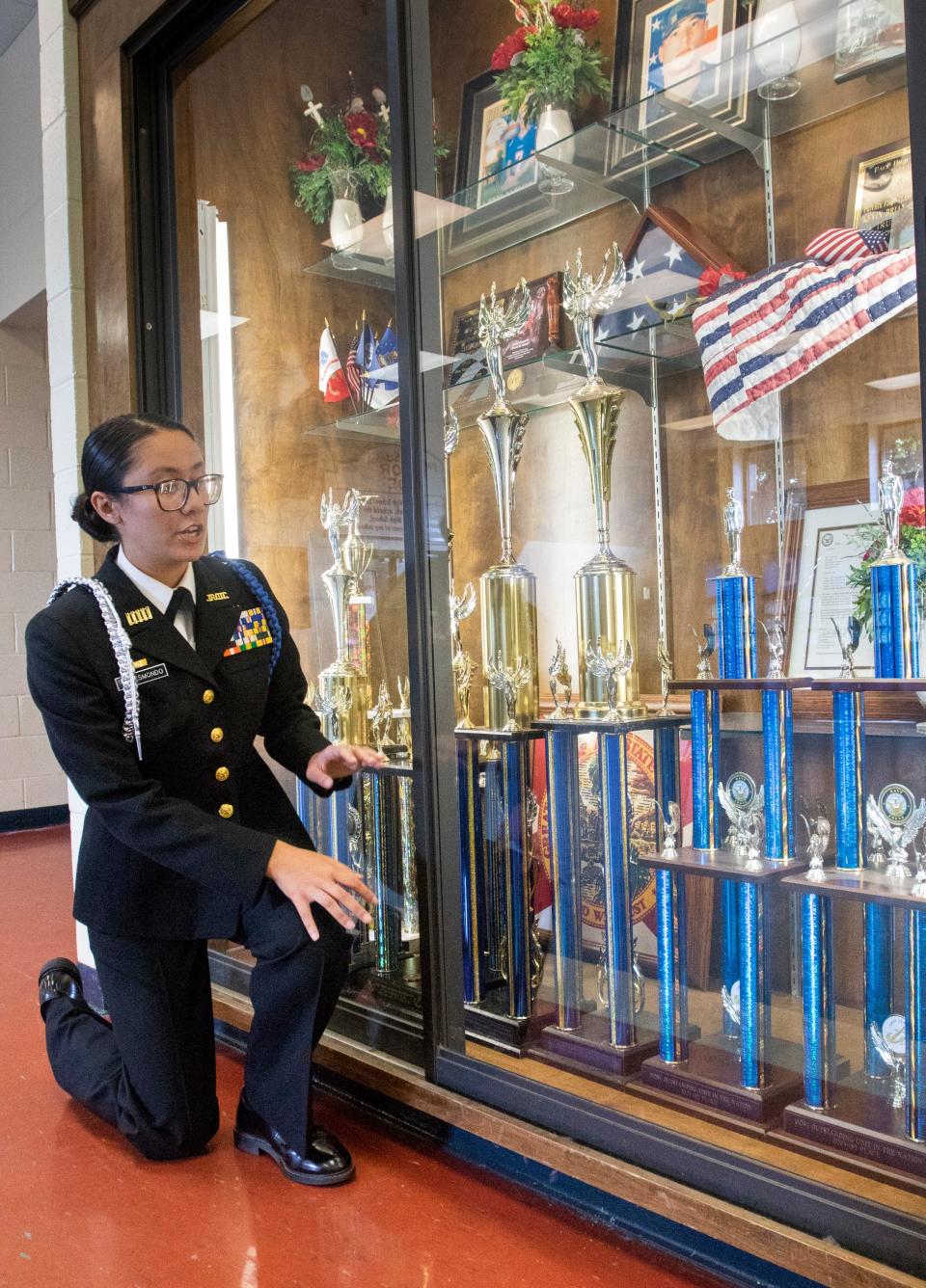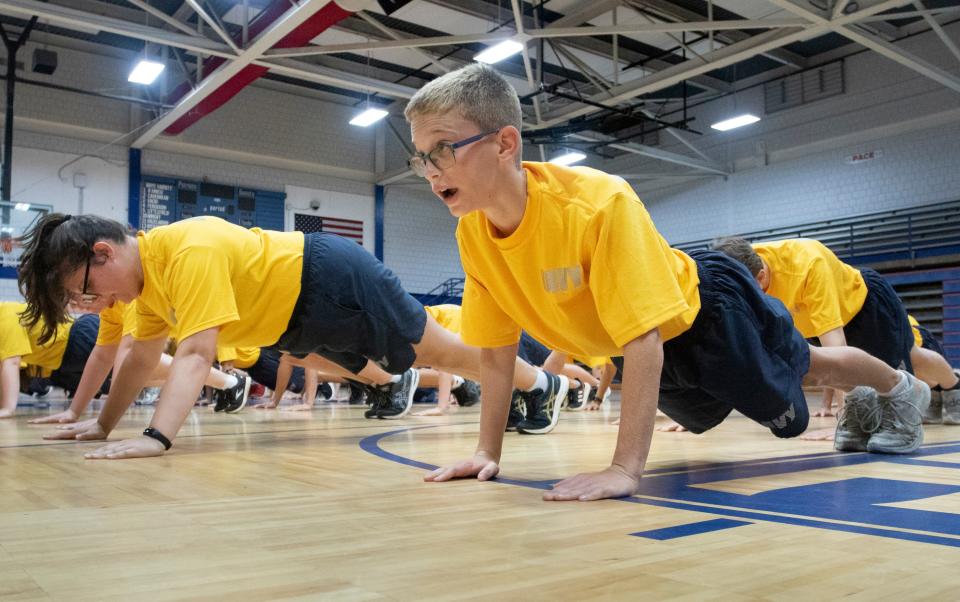'The goal is make you great along the way': Why thousands enlist in JROTC programs
It's hard not to see the U.S. Navy's presence in Pensacola. There are many clear days when all one has to do is look up to see the Blue Angels in the skies overhead. Strong ties to and a love for the military bond residents and are a central part of Pensacola.
So it should come as no surprise that junior ROTC programs are big in the community.
There are approximately 10 junior ROTC programs encompassing multiple military branches between high schools in Escambia and Santa Rosa counties that range from about 70 to over 150 students every year.
Champions: Pace High School Navy JROTC drill team wins national championship
Running it back: Pace High NJROTC wins back-to-back national championships. This is the key to its success
Multiply those graduates by 10, 20, 30 years, and there are now thousands of former junior ROTC students living and working in Pensacola, lending an oversized influence to the program.
"Our mantra — and I think it's shared with all the other program instructors in the area —our mantra is just get them to have a plan after high school. The whole idea here is to teach them some organizational aspects to life," said retired U.S. Navy Capt. Michael Fisher, who runs Navarre High School's Navy JROTC program. "When you graduate high school and mom and dad's purse strings are most likely going to be cut, you are going to start feeling more independence, but with that independence comes the responsibilities."
Preparing students for 'once you're on the other side of the ROTC door'
Local JROTC program instructors told the News Journal that slightly less than 50% of their students end up enlisting in a branch of the military. But even if they don't enlist, they will graduate high school with an understanding of military values, thanks to their ROTC programs.
"We do not overly or overtly tell them to go into the military," Fisher said.
Students can choose to take a JROTC class as an elective and learn aspects of military history, values, traditions and drill instructions, as well as how to perform a proper push up, navigate woodlands with a compass and properly handle an air rifle.
At many schools, the class counts as a basic elective credit the first time a student takes it. Depending on the school, students receive a physical education credit if they take it twice and a performing arts credit for the third time.
School navigators success: Escambia County school navigators so successful, program may continue after funding stops
More key education news: Escambia Children's Trust awards first funds from $10 million pot
Instructors and students alike attest JROTC is about more than the work that happens in the classroom. For starters, program directors like Fisher try to lessen the future shock of independence their students may feel after graduation. Over the summer, Fisher takes the students to colleges and has them talk to college students about their own post-graduation experiences.
"The idea is to keep them on track, to keep them focused on graduating from high school and coming up with a plan so that they are not really a burden on society," he said. "What we teach is the importance of what you are learning once you're on the other side of the ROTC door."

Last week, the Navarre High School Navy JROTC took a trip to tour Georgia Tech University, as well as attend Six Flags Over Georgia.
The large group of teens and their instructors stopped to eat at a Cracker Barrel. Fisher walked into the restaurant first, while the students were still pouring out of the bus, warning a hostess that a party of JROTC kids was about to come flooding through the doors.
"The girl says to me, 'Hi! Oh, yes! I'm a Marine Corps ROTC, graduated this last year. I love you guys,'" Fisher recalled. "I asked her if she was going into the service, and she said, 'No, but it taught me so much.' I was like, oh man, she's the poster child. right there, for the program."
Competitions challenge students in many different areas
The programs routinely compete in local and regional competitions, and the JROTC teams from Santa Rosa and Escambia counties routinely win. Competitions range from marksmanship to athletics to academics and what is called orienteering — basically scavenger hunts by students using compasses.
"Each of those different competitive teams gives students an opportunity to get involved," said retired U.S. Marine Corps 1st Sgt. John Baker, who leads the Pace High School's Navy JROTC. "Maybe they're not potentially going to be the star quarterback or shortstop or something like that. But they've got an opportunity to get in and compete."
The Pace High Navy JROTC has won the Navy National Drill Championship each of the last two years, and this year for the fifth consecutive year, it was named "Best Program in Area 8," which includes more than 60 Navy JROTC programs from the Florida Panhandle, Alabama, Mississippi, Louisiana and Houston, Texas.
More: Myrtle Grove Elementary is coming down and won't be rebuilt until 2025. What happens now?
'Mr. Bus Driver': Pensacola's 'Mr. Bus Driver' has millions watching on TikTok, but his No. 1 fans are students
Sadie Resmondo is a 16-year-old senior at Pace High and the program's highest-ranked student, referred to as the cadet commanding officer. Resmondo also plays on multiple Pace High sports teams but said the nature of ROTC competitive teams has a different feeling than something like volleyball or track.
"I play multiple high school sports, and one thing that really sticks out with ROTC for me is that when you go into ROTC, we look for potential," she said. "We build off of that. In sports, you often have to go in being great. But in ROTC, the goal is make you great along the way."
Retired U.S. Navy Lt. Cmdr. Rodney Bolling, a senior naval science instructor for Pine Forest High School's Navy JROTC program, said not all competitions center on drills or marksmanship.

"The things we do are not all centered around the military," Bolling said.
On Thursday, Pine Forest Navy JROTC's academic team left Escambia County and headed to Washington, D.C. After advancing through two online competitions, the academic team — which includes Ian Vasquez, Sarah Rudd, Randall Geoghagan and Malcolm Chaney — earned a spot to compete in the 2022 U.S. Navy JROTC Academic Bowl Championship.
"We do military things, but we also teach them good self-discipline skills, to be productive, to do the right thing, and to have integrity," Bolling said.
'I wanted to be the best of myself going forward forever'
Another key part of the program is helping students find their confidence.
"This program helps a lot of students out," Bolling said. "Some students come in shy, reserved, but by the time they become a senior, they're outspoken, able to get in front and talk to people and so forth."
Elizabeth Patat, a 15-year-old rising junior at Pace High, said she was not "a very talkative person" when she entered high school.
"I'd say it took a lot for me to get more sociable, but ROTC definitely helped with that. It made me have to talk to more people," Patat said.

More: Pace High's Navy Junior Reserve Officers Training Corps receives top national honor
As a sophomore, Patat was given the duty of looking after and guiding the freshmen in her Navy JROTC course, and the assignment forced her to become a better communicator. It's not that she lost shyness overnight, but the program did build her confidence over time, she said.
Connor Schuster, a rising 16-year-old senior, suffered from generalized anxiety before joining Pace's program.
"I had a lot of social anxiety going into it, in general and in the program," he said. "Basically, going into my junior year, I was put in the position of being a platoon commander."
There are six ROTC class periods during the school day at Pace High, and every period is assigned a platoon commander who acts as the class leader and takes attendance, selects classmates for community service, and gives updates and general announcements.
Schuster forced himself to confront his anxiety to become a better platoon leader.
"Starting out the year, I had a really hard time talking and like I was always stuck on what to say. I would always freeze up, and I really had a hard time," Schuster said. "But basically, I would say halfway through the year, I kind of, I would say, 'sparked.' Like I wanted to be the best of myself going forward forever."
Colin Warren-Hicks can be reached at colinwarrenhicks@pnj.com or 850-435-8680.
This article originally appeared on Pensacola News Journal: JROTC programs help shape thousands of Escambia, Santa Rosa leaders

